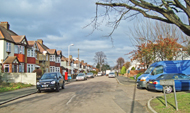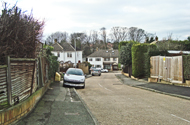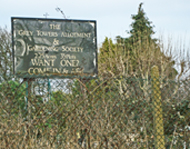Convalescent (military)
At the outbreak of WW1 the Army Council took over Grey Towers, a large country mansion, and its 85-acre grounds. The property was vacant and had been put up for sale in June 1914 after its owners, Col. and Mrs Holmes, had died.
It had been decided that Grey Towers would be a suitable site for a military depot. A hutted camp was erected in the grounds and this was ready for occupation in November 1914. It became the Battalion Headquarters of the 23rd Royal Fusiliers, otherwise known as the First Sportsman's Battalion, a unit based on proficient sportsmen who, by special dispensation, could be recruited up to the age of 45 years. (The mostly amateur sportsmen, including cricketers, big-game hunters and mountaineers, came from all over the world. As the war progressed the unit effectively became an Officers Training Corps, similar to the Artists' Rifles.)
After six months of training, the Spontsman's Battalion departed in June 1915. It was replaced in November by the 26th Middlesex Regiment (the Navvies' or 3rd Public Works Pioneers' Battalion), who themselves departed in December.
In January 1916 Grey Towers was selected to be the first Command Depot for the New Zealand Contingent in England.
After the first major actions involving New Zealand troops on the Western Front, large numbers of wounded began arriving in England duing April and May 1916. By this time it had been decided that the Hornchurch site was too small for a Command Depot and that it should be used for a convalescent hospital for New Zealanders instead. As a training camp its facilities had been very basic and considerable work was carried out to make it suitable for its new role.
The New Zealand Convalescent Hospital opened in July 1916 with 1500 beds. The first patients were transferred from the Canadian Military Convalescent Hospital in Woodcote Park, Epsom, to complete their convalescence. The aim was to return soldiers to the Front within six months; if the prognosis was longer, it was considered economic to send them back to New Zealand. (In fact, the long sea voyage was often more curative than a hospital stay, and many of those invalided home returned to the fighting later.)
Hospitals had already been established for New Zealand servicemen at Brockenhurst in Hampshire, Codford in Wiltshire and Mount Felix in Surrey, but their capacities were limited and it was soon realized that the Hornchurch unit would have to become a composite auxiliary and convalescent hospital. An aseptic surgical unit was established, as well as an extensive Electro-massage Department and a Mechano-therapeutic Department with a well-equipped medical gymnasium.
The Hospital was soon extended to accommodate 2000 (and, later, 2500) patients.
At first there was not much to occupy the convalescent patients. In March 1916 four ladies had organised a small hut in Hornchurch which had reading and writing facilities but, as the numbers of New Zealand troops increased, a house in Butts Green Road was built with the help of army carpenters. Beethoven House, also in Butts Green Road, once the Metropolitan Academy of Music - a private school, had been opened as a canteen and Soldiers' Club by Miss Hilda Williams, a New Zealander who had already established The Dug-Out, the first canteen for New Zealand troops in Victoria Street, London. Beethoven House was renamed Te Whare Puni (The Meeting House) and was staffed by New Zealanders and 'ladies from the Old Country' (that is, the English).
The New Zealand War Contingent Association provided a large hut in the Grey Towers grounds, paid for by Patriotic Funds. The hut had a canteen, hall, billiard room and reading and writing room. The New Zealand branch of the YMCA provided a similiar hut, also equipped with a canteen, billiard room, a large hall which could seat 800-900 people, and a large reading and writing room. It also had an 'arts and crafts' workshop.
The Church Army also opened a hut. The canteens and mess rooms were staffed entirely by women sent from the Voluntary Aid Detachment headquarters at Devonshire House, London.
The parts of the grounds not occupied by huts were cultivated, both for the Hospital food supply and to provide agricultural training. Some 40 acres were under crops and there was also a rabbitry and a poultry farm.
In 1918 the YMCA hut's 'Arts and Crafts Department' was extended. Two substantial workshops were added, similar to those established at the Military Orthopaedic Hospital at Hammersmith, as well as seven educational rooms and a motor engineering room for training purposes. A School of Massage was also set up. (However, these were not formally opened until after the Armistice.)
By the end of 1918 some 20,000 patients had passed through the Hospital.
The New Zealand Contingent evacuated Grey
Towers in June 1919 (the last New Zealanders left England for home on
16th February 1920).
Present status (January 2011)
Grey Towers was demolished in 1931. The last country house to be built at Hornchurch, it had a short life.
Built in 1876 in a 12th century style by Col. Henry Holmes, the owner of the nearby Hornchurch brewery, it had a castellated roof line. The entrance hall had a carved oak ceiling and the staircase was made of black and white marble, with a fine stained glass window at the top landing.
Lt. Col. Henry Holmes, J.P., had been Deputy Lieutenant for Essex and was very much involved with local affairs. In 1882 he had raised a battery of the First Essex Artillery Volunteers and had retained the title of Colonel after it had disbanded in 1898.
When the New Zealand Contingent departed in June 1919, the Hospital huts were occupied by the No. 2 Transfer Centre, which organised the staffing of demobilisation centres around the country, and the transfer of troops between various parts of the services. This unit was disbanded in November 1919, marking the end of the military occupation of Hornchurch.
Today new housing occupies the site of the house. The driveway has become Grey Towers Avenue. The fountain, once located in front of Grey Towers, is now in the rear garden of one of the houses along Grey Towers Avenue. The two lodges, both also in the same cassellated style as the house, in the High Street at the entrance to the driveway survived for some years, but have now also been demolished.
Te Whare Puni at 43-45 Butts Green Road is now occupied by the firm Vantis (now FRB Advisory).


Grey Towers Avenue was once the driveway to the country house (right). The house itself was located on the part of Grey Towers Avenue which turns to the left (right).


Grey Towers Gardens was built on the grounds at the back of the house.

Allotment plots occupy part of the grounds.
St Andrew's Church
The Church is a Grade I listed building and contains memorials to the soldiers stationed at Hornchurch during WW1.
On the north wall of is a brass plaque commemorating the horrendous losses of the Sportsman's Battalion during the war. The left pane of the west window shows the arms of New Zealand, in memory of the New Zealand servicemen stationed at Hornchurch.
The graveyard contains 37 graves from WW1, including 4 New Zealanders from Niue, members of the 3rd Maori Contingent and 3 Canadians.
Perfect CT 1920 Hornchurch During the Great War - An Illustrated Account of Local Activities and Experiences. Colchester, Benham & Co.
Pointer M 2000 Tagi tote e loto haaku - My Heart is Crying a Little: Nine Island Involvement in the Great War, 1914-1918. Suva (Fiji), Institute of Pacific Studies, University of the South Pacific.
http://1914-1918.invisionzone.com
http://find.natlib.govt.nz
http://paperspast.natlib.govt.nz
http://seax.essexcc.gov.uk
http://warart.archives.govt.nz
http://yourarchives.nationalarchives.gov.uk
www.british-history.ac.uk (1)
www.british-history.ac.uk (2)
www.gilliesarchives.org.uk (1)
www.gilliesarchives.org.uk (2)
www.gilliesarchives.org.uk (3)
www.gilliesarchives.org.uk (4)
www.gutenberg.org
www.havering.gov.uk
www.historyofstratford.co.uk
www.london1912.co.uk
www.netz.org
www.shopwiki.co.uk
Return to home page